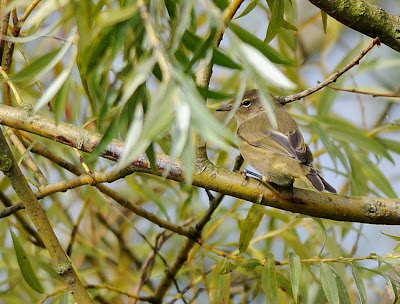After months of deliberation, weeks of checking secondhand suppliers and days of tension watching ebay, I got my mitts on a used 300m f4 lens on Saturday. Rob had half-heartedly encouraged me to wait to see if Nikon produced an updated version of this 10-year-old model with VR, but as such a lens didn't seem to be on the horizon at all, when I found a well-priced used one on ebay I went for it.
The lens had its first outing to - where else? Sevenoaks Wildlife Reserve. Post-lunchtime on a Saturday meant it was pretty busy, and also it was a rather gloomy afternoon, but not a problem for putting the new lens through its paces. We went to the Grebe hide and Rob had fun photographing birds at the feeders with the 70-300mm while I pointed new lens at some Chiffchaffs in a willow by the water.
Tits first. The juvenile Blues and Greats are starting to moult into adult plumage. Mid-moult is not a prepossessing look but it's interesting. The glossy black adult feathers appearing on this young Great Tit's crown show just how much paler and duller the juvenile crown feathers are.
The young Blue Tits were more advanced, but you can still see bits of grey on the crown among the blue feathers, and a hint of yellow lingering on the cheeks.
And the Chiffchaffs? Well, that willow is a long way down. Here's a full frame of the clearest shot I got. The Chiffchaff is in the middle. Look carefully... It's tiny in the frame, but how does it look when cropped to a more sensible size?
It looks surprisingly sharp if you ask me. A massive crop like this on the Bigmos would be a blurry disaster.
I put the teleconverter on after this (a Kenko 1.4) but got no better views of the Chiffchaffs, so went out in search of more obliging quarry.
First I tried a few macro shots in the wildlife garden. I think this is a Honey Bee-mimicking hoverfly, in the little fake cornfield. Sorry about the green mesh.
At Willow hide, a young Pied Wagtail was wandering about on the muddy areas. Very little else there - loafing geese, a few Gadwalls, one sleepy Tuftie, zero Green Sandpipers. It would take a long time to list all the other birds that weren't there, so let's move on.
Next we went to Bough Beech, where we saw nothing photographable, then I returned to SWR for a sneaky extra hour. Back at Willow Hide, there was now a Green Sandpiper on view and, what's more, it was on the near shore (albeit the furthest possible point of the near shore, and almost lost behind the foliage). I watched as it picked its way towards the hide, making very slow progress as it kept going back on itself. Then something spooked it and it turned around and ran back out of sight. This was as close as it got - it's another heavy crop.
I had more luck with this young Lapwing. It flew in with a cheerful whoop, landed among the geese and waded along the muddy edge right in front of the hide, pausing frequently to grab wriggling muddy morsels at its feet.
I'm well pleased with the lens. One problem is that a few times it misbehaves and reports a rapidly dropping light level when there isn't one. Rob thinks this is a loose connection on one end or the other of the teleconverter. It gave me all kinds of grief on Sunday (see next post) but since taking it off and putting it on again (a variation of the IT panacea) it's been OK. Touch wood. If it does it again the teleconverter's going back. The lens seems fine on its own.
Subscribe to:
Post Comments (Atom)









1 comment:
Nice shots. I love Willow and Carter hides
Post a Comment